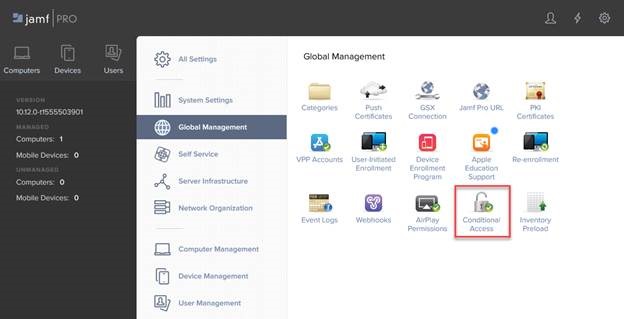

Once Jamf Connect Login is registered as a native app with Azure, you can configure settings to assign users and designate app roles. Step 2: Assigning Users and Designating Roles Under "Default client type", switch the Treat application as a public client setting to Yes. Under "Manage" in the sidebar, click Authentication. Navigate to Jamf Connect app registration. Under "Grant Consent", click Grant admin consent for your company and then click Yes when prompted. Under "Manage" in the sidebar, click API permissions. Navigate to your Jamf Connect app registration. Select Accounts in this organizational directory only under "Supported account types".Ĭhoose "Public client (mobile & desktop)" from the Redirect URI pop-up menu, and then enter a valid URI, such as "", in the Redirect URI field. Complete the following steps to create a new app registration:Ĭlick the Azure Active Directory in the left sidebar.Ĭlick App registrations, and then click new registration. You must integrate Jamf Connect with Azure by registering Jamf Connect as a web app. Step 1: Registering Jamf Connect Login with Azure

Configuring File Shares with Jamf Connect Verify.Integrating Kerberos with Jamf Connect Sync.Configuring File Shares with Jamf Connect Sync.Configuring Jamf Connect Login with PingFederate.Configuring Jamf Connect Login with OneLogin.Configuring Jamf Connect Login with Okta.Configuring Jamf Connect Login with Microsoft Azure AD.Configuring Jamf Connect Login with IBM Cloud Identity.Configuring Jamf Connect Login with Google ID.General Requirements and IdP Compatibility.In the meantime, head to Apple Business Manager to begin testing the integration today. Next stepsĪpple Business Manager’s federated authentication with Azure AD is a big deal and something we are excited to continue talking about. User Enrollment is Apple’s new “ BYOD” system that helps IT admins manage personal devices in the workplace, while still protecting user privacy. Flexible enrollmentįinally, Federated Authentication for Managed Apple IDs is supported for both user enrollment and device enrollment. Instead, Azure AD is able to verify a user based on their iCloud account and will automatically create a local account when that user is verified. Gone are the days when a user had to sign in multiple times or manually create an account during setup.

One of the best parts about leveraging Azure Active Directory with Apple Business Manager is how you’ll be able to simplify the setup and login experience for your end users. Azure AD is able to verify a user directly within the native setup steps. Additionally, the integration is nearly invisible. With Apple Business Manager support, you are now able to easily integrate your existing Azure AD credentials into your device setup process. If your organization is in the same boat, you will know how important it is to continue leveraging that infrastructure while also modernizing your deployment plan. Over the years, many IT teams have made significant investments in their Azure Active Directory service, Microsoft’s identity system that allows organizations to maintain a “source of truth” for all users. It was a huge announcement and something that anyone running Azure AD will want to take a look at.įederated authentication was previously available for Apple School Manager and was even in beta for Apple Business Manager but this is the first time it is fully available for users on either service. Last week, Apple announced that Apple Business Manager was adding support for federated authentication with Azure AD. Apple Business Manager is one of the most powerful services available to IT admins deploying and managing Apple at scale, and recently it got even better with support for Microsoft Azure Active Directory (AD)!


 0 kommentar(er)
0 kommentar(er)
